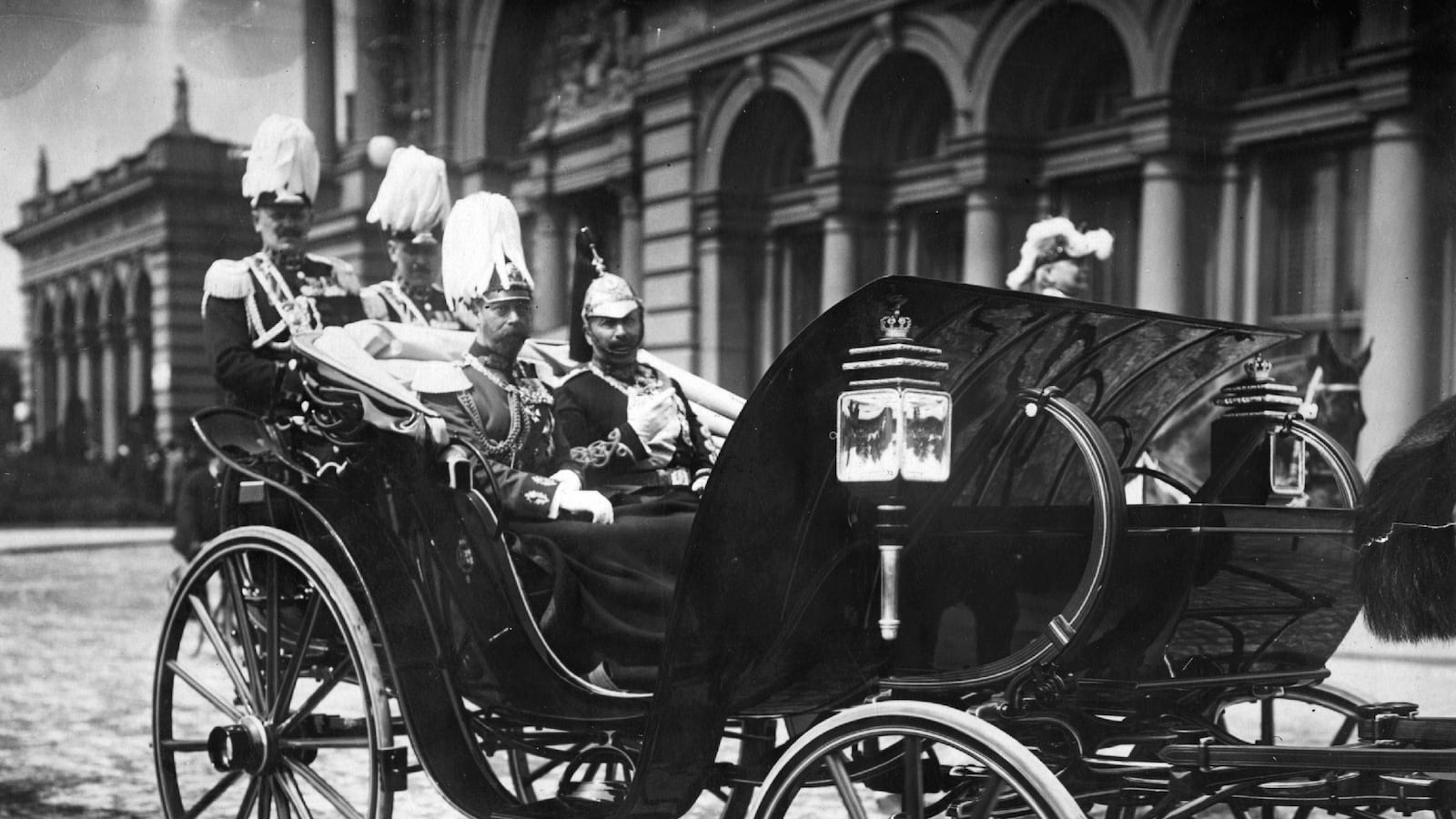In 1913 several European cousins met to celebrate a wedding. Pretty much everyone had a great time and was well behaved. The relatives included Tsar Nicholas II, King George V, and Kaiser Wilhelm II. "Guests who rule a third of the world," proclaimed a newspaper headline. The wedding was between Princess Victoria Louise, known as "the little princess," the only daughter of the German kaiser, and Prince Ernst August of Cumberland. The hymeneal rites were seen as an auspicious sign for future comity in Europe. When Kaiser Wilhelm met King George, the former wore a British uniform set off by the broad blue ribbon of the British Order of the Garter, while his British guest had donned the uniform of the Prussian dragoon guards and a sash denoting him as a member of the Prussian Order of the Black Eagle.

Yet only a year later the monarchs of Europe had plunged into war, engaging in a kind of mutual suicide pact with Vienna serving, as the Austrian satirist Karl Kraus put it, as the "proving ground for world destruction." Mass slaughter led to the demise of empires that had once looked secure. The Romanov empire? Toppled by revolution. The same went for the Hohenzollern and Habsburg monarchies. A few decades later, it happened all over again, as the Nazis launched a second German bid for world hegemony.
Why did it all go wrong? Was it inevitable? And does the collapse of peace and economic interdependence, at a historical moment when you didn’t even need a passport to visit a neighboring European country, suggest any lessons for our own age?
In 1913: In Search of the World Before the Great War, Charles Emmerson offers a close look at the year before the war broke out. With the looming 100th anniversary of World War I, a spate of books about the not-so-Great War have begun to emerge. Emmerson's effort stands out for several reasons. First, Emmerson ranges widely, from Germany to Paris, from Bombay to Tokyo. Second, he is a sparkling writer, his narrative rarely flags, and he has amassed a startling amount of detail. His aim is to show that while there were latent tensions in 1913, it would be wrong to suppose that government officials or citizens assumed that conflict was inevitable. It was a year of possibilities, not predestination. Still, the lurch into war does provide a reminder that comity and financial interdependence between nations can quickly devolve into war, particularly countries that are boisterously seeking, as China does today, their place in the sun, as Wilhelmine Germany once did. But once the bellicosities were initiated—triggered by the assassination of Austrian Archduke Ferdinand in Sarajevo by a Serbian nationalist named Gavrilo Princip—all bets were off. The Austrian novelist Stefan Zweig recalled, "All the bridges between our today and our yesterday and our yesteryears have been burnt." The "golden age of security," he lamented, "was gone."
Emmerson goes to some lengths to rediscover it. London seemed to many the epicenter of the world at the turn of the century, and Emmerson devotes much of his attention to its "role as meeting place of the world's money," which appeared to be "mandated by economic law." President of the Board of Trade Winston Churchill assured his Manchester constituents that "it will be the same when the year 2000 had dawned upon the world." But rot lurked beneath the gleaming efficiency of British trade and industry. The Marconi scandal, in which government ministers, including David Lloyd George, had purchased stocks in a company that was going to establish a chain of wireless stations around the world at the behest of the British government, created a public uproar. Emmerson says that the "Marconi scandal left a bitter taste at the heart of London and the heart of empire, implying the corruptibility of both."

Still, the British were not assailed by the kind of self-doubt that hobbled the French, who had the misfortune to be located next to a rising German industrial and military power. "One single agonizing problem should occupy the all the thoughts of France," wrote Jacques Bertillon in a surprise bestseller: "How to prevent France from disappearing? How to maintain the French race on earth?" Which is a question that French nationalists continue to brood about. At the turn of the century racial theories flourished. Emmerson notes that one German declared that "a people who do not want to be soldiers and whose women refuse to have children is a people benumbed in their vitality fated to be dominated by a younger and fresher race." Just what was "younger and fresher" about the Germans is unclear. But in 1913 France was a great country by the standards of the times—it had one of the world's larger navies and the second-largest empire, ranging from Indochina to Guyana. According to Emmerson, "at the Bastille Day march past at Longchamp in July 1913, Poincaré presented the flag to twenty-five colonial regiments, from Algeria, Morocco, Senegal, Indochina, Madagascar, Chad, and Gabon."
But it was the Germanophile and American author Theodore Dreiser who diagnosed the future of Europe. "Paris has had its day," he said. "London is happy with an endless conservative day," he added. But it was Berlin that was on the march—"the blood is there, and the hope, and the moody, lustful Wagnerian temperament." Emmerson focuses on Berlin as the nervous locus of the new German empire, an industrial powerhouse, a capital of science, and a city on parade. Emmerson notes, "In 1895 the city had eight times as many telephones per head of population as London; by 1911, even after the prodigious growth of telephony all across the world, it still had twice as many as the capital of the British Empire." The contradictions of the empire were epitomized by the restless Kaiser Wilhelm, who wanted to have a big shiny navy to compete with his British cousins, but also longed to be known as a peacemaker and, indeed, saw himself as "the master of European diplomacy," writes Emmerson. But his own emotional inner turbulence, captured in Thomas Mann's sadly neglected novel Royal Highness, was reflected both in Germany's erratic foreign policy and Berlin's frenetic pace. Long before the Weimar era, Berlin had a bustling, racy character, a coltish sense of perpetual adolescence that resembled the Kaiser's own personality. It was the parvenu of cities and the city of parvenus.
If Berlin was on the march, Vienna was wedded to nostalgia. Its credo had been to muddle through: "In Berlin things are serious but not hopeless; in Vienna they are hopeless but not serious." The old Kaiser Franz Joseph, faithful and hardworking, was the obverse of the feckless and impetuous German kaiser. Franz Joseph lit the Hofburg Palace with kerosene lamps and viewed the telephone as a nuisance. But it was the Austrians who in a fit of fatalism sent the démarche to Serbia that triggered World War I. Emmerson reminds us that there really was no such things as a coherent Austrian nation; rather, it consisted of jostling nationalities cobbled together by various Habsburg emperors over the centuries. The monarch was a fading concern: "Though it still had considerable cachet among European centuries," Emmerson somewhat observes, "Vienna was no longer in the same category as London either as a political force or even simply as a city." The Wiener Montags Journal complained, "Vienna has no nightlife, the Viennese are asleep by ten." Still, with the likes of Sigmund Freud, Karl Kraus, Adolf Loos, Arthur Schnitzler, and Ludwig Wittgenstein living in Vienna, it did serve as what Emmerson aptly calls a "crucible for cultural experimentation. This was Vienna's signal paradox: that such a bastion of tradition could also be a forcing-house for modernity." At the same time, anti-Semitism was percolating in Vienna as the mayor of the city, Karl Lueger, decried the influx of Orthodox Jews from the East.
Here is the nub of the matter, the explosive combustible mixture of nationalism and modern technology that led to World War I. Scientific advances led to a form of warfare that the rulers of Europe could hardly have imagined—poison gas, tanks, airplanes even as the most brutal aspect of the war was prolonged trench warfare. The cozy days of lighting the Hofburg Palace with kerosene rather than electricity had come to an abrupt end. Newer, more brutal forces were emerging. For all the great cultural experimentation limned by Emmerson, it was an unemployed tramp from Vienna with a penchant for artistic glory who ended up proving the most significant and lethal product of this era.






